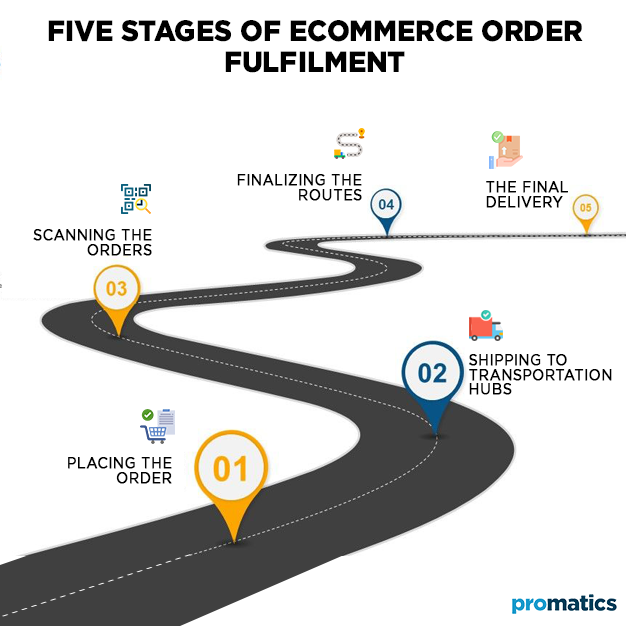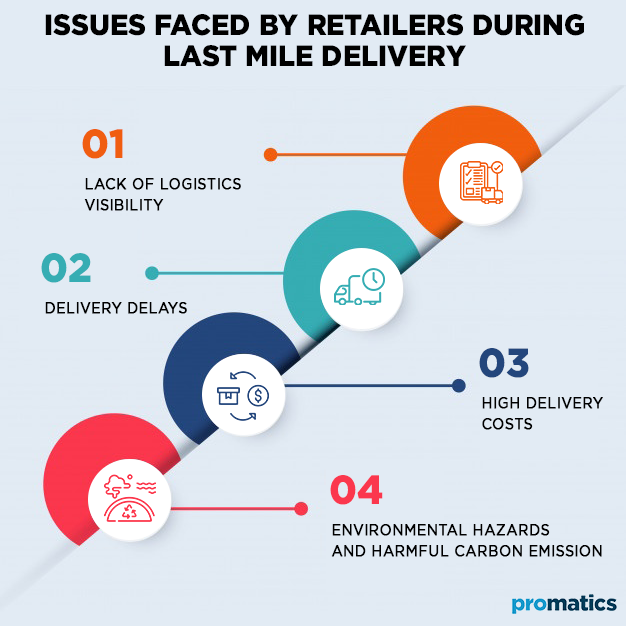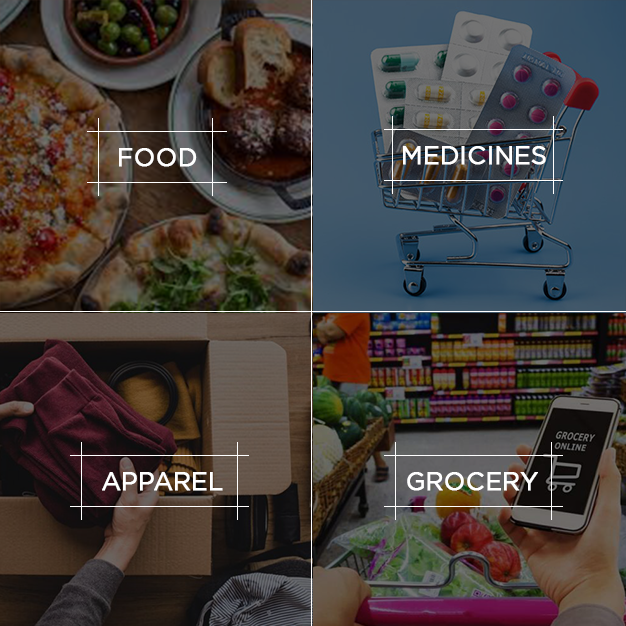What are Last-Mile Delivery Apps? Where Role do they Play in Order Fulfilment?
Many people have been reluctant to go out shopping, but the percentage of individuals who are not reluctant has significantly dropped ever since the covid pandemic started. With the constant fear of being infected, even after getting vaccinated, people would rather have someone drop off their consignments to their homes rather than have to go and buy them. This opened a whole new set of opportunities for businessmen to start last-mile delivery apps. Now, the market is almost saturated, so if you are thinking of launching such an app, stay with us till the end of the article to know all about how to make your venture a success.
What is Last-Mile Delivery:
You must have all the basic knowledge about last-mile delivery before we start a conversation about how to build a profit-making last-mile delivery app. Last-mile delivery, also called final-mile delivery, is the last leg of a supply chain operation. It is the final part of the product’s journey in which it is delivered to the customer.
An error-free delivery takes place in these 5 steps:
I.) Placing the order: The customer places an order through the app or website. The order is then entered into the company’s centralized system.
II.) Shipping to transportation hubs: Once the order is confirmed, the consignment is shipped to a nearby transportation hub from where it will be delivered to the consumer.
III.) Scanning the orders: To double-check, the warehouse staff scans the orders before loading them into the delivery vehicles so that the orders do not get mixed.
IV.) Finalizing the routes: According to the delivery address, the packages are loaded in the right vehicles. All the products to be delivered to nearby areas are assigned to the same vehicle, after which the drivers follow the most efficient routes.
V.) The final delivery: Once the order reaches the customer’s home and is personally delivered to them, the proof of delivery is recorded.
Problems Faced by Retailers During Last-Mile Deliveries:
If done without any hiccups, last-mile deliveries can work wonders for your business. To stay alive in this competitive market, especially with giants like Walmart and Amazon Prime, you can not afford any mistakes. Here are some of the obstacles that you might face while shipping your product to a target customer so that you develop a plan to counter them timely:
a.) Lack of logistics visibility: Modern-era customers have this non-negotiable demand for complete transparency where they want to know the exact details of where their product is along with an accurate expected delivery time, even for same-day deliveries. But, sadly, this kind of transparency is difficult for most businesses to adopt.
b.) Delivery delays: Delivery delays are a retailer’s worst nightmare. And what’s even worse is, most of the time, there is nothing that the company can do to prevent a delay from happening. A flat tire, terrible weather conditions, or traffic issues are a few common reasons a package does not get delivered on time.
c.) High delivery costs: According to statistics, the last-mile delivery alone costs almost 1/3rd of the entire delivery cost. Driver salaries, vehicle maintenance, fuel costs, long routes, and unsuccessful deliveries make things even more complicated. These challenges can sometimes become too much for a company and can even, in the worst-case scenario, lead to bankruptcy.
d.) Environmental hazards and harmful carbon emission: Last-mile deliveries involve heavy vehicles to deliver the products to the customers, which greatly contribute to environmental pollution. With the increase in environmental hazard awareness, customers demand carbon-neutral drivers and eco-friendly deliveries to curb pollution.
What are Last-Mile Delivery Apps? And Where Do They Lie in All This:
Since every aspect of our day-to-day business has started to rely on software and technology for increased productivity, why should eCommerce stay behind? A last-mile delivery app helps you make a streamlined process for timely and convenient deliveries.
Using a last-mile delivery app can prove extremely beneficial for your business, especially compared to conventional means and legacy systems. For this reason, last-mile apps are taking the world by storm. We recommend that if you have not made the switch to a last-mile app yet, now is the time to do it. Otherwise, you will surely miss out on these benefits:
i.) Better visibility and transparency: We talked about how a lack of logistics visibility can hurt your business. With a last-mile delivery app, you will not have to worry about that. Your customers will be satisfied by the enhanced shipment visibility and complete transparency regarding their package. As a result, their trust in you will undoubtedly increase, which will surely play a big part in retaining customers and attracting your competitor’s clients.
ii.) Increased flexibility: With the old-school system in place, it was almost impossible to track the delivery accurately. Many companies face a significant setback financially due to order returns, especially when the customer is not there to receive the order. None of this happens with the increased order flexibility of this system. Your customer knows where the courier is and makes necessary arrangements timely so that the courier does not face any inconvenience. Or, the customer can even change the drop-off location, and the delivery guy will instantly know it.
iii.) Enhanced productivity and reduced risk of error: Unplanned errors are the worst because one can not stop them from happening. But, with an efficient last-mile app, you can most certainly reduce the risk. Most savvy business models thrive off the fact that their truck drivers, couriers, and delivery guys are on the best route that will get them to deliver the product in the minimum amount of time. As a result, you will see a significant boost in productivity that will undoubtedly benefit you, your drivers, and the customer.
iv.) Better data management: When each business model component gets connected to the rest, it automatically makes it easier to collect data and organize it. Moreover, digitization at every level plays an influential role in keeping tabs at the warehouse, better inventory management, and data tracking. Hence, it is almost imperative to get a robust last-mile solution.
Important Features of a Last-Mile Delivery Platform:
To have a last-mile delivery platform that becomes a roaring success, you have to have these features in your app:
- Smart tracking: We have talked about this time and again about how critical and fundamental smart tracking is. If you are about to launch your last-mile delivery app and have not included a smart tracking feature in it, delay the launch date and make a real-time tracking system a part of your plans.
- In-app payment integration: Many customers get an anxiety attack after realizing that they do not have any cash at home to pay for the delivery. For this purpose, you need to have an in-app payment integration so that customers can pay for COD parcels digitally.
- Appropriate substitutes within target categories: Your last-mile app can target any of the mainstream categories of your convenience and liking whether food, groceries, medicinal items, or apparel. To make your platform better than the others, you can add a feature that provides appropriate suggestions if anything in the customer’s cart is out of stock or unavailable. For instance, if someone wants to buy Chinese food from a specific restaurant that is closed, your app can provide the customer with similar Chinese restaurants that are open and available. All food delivery apps have this feature nowadays.
- Online chat and customer feedback: Customer feedback is one of the most important features of any business model. Having reviews and feedback allows you to improve your business model and deal with the flaws and shortcomings noted by the customers and users. Online chats improve your retailer-customer relationship by providing a platform where your customers can get their queries answered.
Some Popular Last-Mile Apps to Look Up To:
If you are about to build a last-mile app from scratch, take a leaf out of these apps’ books:
- Postmates:
Postmates is one of the most successful, if not THE most, delivery apps globally. It has an around-the-clock surface that allows you to order anything anywhere and anytime.
Postmates has a strong financial model in which they charge a specific amount of money, depending upon the bulk of the order, which is then split 80/20 between the delivery guy and Postmates. In addition, they also demand a 9 percent convenience fee on every order, irrespective of the basket size.
There are several reasons behind their success. They hopped on to the on-demand delivery trend early on and set their aim high. As a result, they instantly got the return on their investment and started counting dollars from day one.
- Delhivery:
You can be as critical as you want, but you will end up labeling Delhivery as one of the coolest startups in this space! Delhivery is a third-party delivery farm that is not just a logistics company but is also a supply-chain enabler.
It is tough to stay in the market with other eCommerce giants such as Blue Dart and FedEx, but their cheap rates and reduced delivery time make it an excellent economical choice. The company has a great business platform based on several delivery flights within a day, ensuring that most of the orders take less than 24 hours to get delivered. Their technological advancement makes sure each order finds its way on the earliest flight and takes the fastest route.
Moreover, they are against the “hub-and-spoke” model that can cause significant delays. Instead, they implement a distributed model where each branch functions as a hub and routes the package directly to the customer.
The success of their last-mile delivery setup speaks volumes as they, according to statistics, generate monthly revenue of Rs. 8-8.5 crore, with 40,000-50,000 orders delivered per day.
- Shadowfax:
It takes a tall order to beat the leading 3PL service provider, or the “Dad” of all businesses, as they call themselves.
The main crux of Shadowfax’s mission is to provide top-notch courier services at a reasonable price with the help of a simple process. And it does not end here. Their turnaround time is so quick, which gives them a seat at the table with other eCommerce tycoons.
Their revolutionary idea of bringing Kirana stores into their business model has tilted the balance to their side. According to them, using smart tech for tracking the orders and keeping tabs on them in real-time pays dividends.
Moreover, their business model incorporates intelligent parcel allocation and demand-supply optimization to make the most of their last-mile deliveries. They have even initiated a method in which their customers can pay for their cash-on-delivery orders digitally with the help of an in-app UPI integration.
Conclusion:
Last-mile deliveries are rapidly becoming more and more common. To keep yourself at a level above your competitors, you will have to be aware of the complications and problems that can occur during last-mile deliveries. You can do that by building an exceptional last-mile app that not only makes things easier for you but also provides an extra level of comfort to your clients. Shadowfax, Delhivery, and Postmates are examples of successful last-mile delivery apps that you should look into before making your app.
Still have your concerns?
Your concerns are legit, and we know how to deal with them. Hook us up for a discussion, no strings attached, and we will show how we can add value to your operations!



